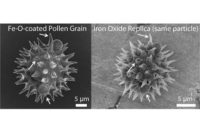
Purdue University scientists have found that the glue that saltwater mussels use to affix themselves to rocks has a scientific interest and potential applications in medicine and industry.
Jonathan Wilker and his research group have discovered that the formation of mussel adhesive requires iron, a metal that has never before been found in such a biological function. While the discovery is valuable for its scientific merit, it could impact the market as well, leading to surgical adhesives, rustproof coatings and antifouling paints to defeat barnacle adhesion.
Mussels stick to objects such as rocks, pilings and each other. Up close, it is easy to see the dozens of tiny filaments - often referred to as its beard - that stretch from a mussel, attaching it to its home turf. A mussel has an organ called a "foot" that it extends, attaching each filament to a stationary object with a tiny dab of glue. The foot then repeats the process until it is secure enough to resist the pull of tides, currents and predators.
According to Wilker, a mussel will take five minutes to make an adhesive plaque, and it uses 20 or more such plaques to anchor itself, easily establishing itself overnight.
The key to the mussel's tenacity is the plaque, or glue, that holds these filaments in place. It is the chemistry of this glue that Wilker and his fellow researchers are studying. Metals such as iron are usually needed only in trace quantities for life, but Wilker's research has demonstrated a novel role for metals: biomaterial formation.
Other organisms that produce materials are being explored as well, such as barnacles, kelp and oysters, to see if there is a common theme in the synthesis of biological materials.
Wilker first became interested in this subject while pursuing one of his favorite hobbies - scuba diving.
"I was looking at mussels and barnacles while diving and wondered how they stick," he says. "I checked the literature for an answer and saw that many of the details for these processes were not known."
This simple question has turned into a lengthy project for Wilker, occupying him since he arrived at Purdue in August of 1999. His work has uncovered a new aspect of bioadhesives, most of which are based upon proteins. Prior to curing, these protein mixtures can resemble gelatin.
"The mixture we extract from mussels has a consistency similar to gelatin," he says. "When we add iron, the mussel proteins crosslink, or 'cure,' and the material hardens. Other bioavailable metal ions do not appear to bring about this crosslinking. Our spectroscopic experiments show how this iron binds the proteins for crosslinking, turning them into glue."
A mussel obtains iron by filtering it directly from its surrounding water. As with other bivalves, such as oysters and scallops, mussels obtain all the nutrients they need in this fashion.
Wilker says that mussels can affix themselves to nearly any surface, including Teflon, the same substance known to make nonstick coatings for frying pans.
Wilker believes the material's ability to adhere to many surfaces and its biological origin will make it useful in medical applications. He claims that the glue could be modified for use in wound closure, nerve reconstruction, or when one might need a scaffold upon which to grow cells and build new tissue.
Another potential application could be in rustproof coatings, often used in outdoor settings such as the exteriors of buildings and cars.
Wilker has found that there are coatings on the market made from polymers, but none are ideal. By using this glue to coat surfaces, a natural rust-proofing compound could be created.
Further research could also reveal a less environmentally damaging way to keep barnacles and mussels from attaching themselves to ship hulls, where they increase drag and reduce sailing speeds.
Wilker and his team recognized that copper-based paints are often used on ship bottoms to kill barnacles in their larval state and prevent them from attaching. This use of copper-based antifouling paints has harmed the marine ecosystem. Copper levels in most harbors are very high. This major environmental problem could possibly be addressed and solved in the future with this current research.
Wilker says he is excited to work in such a fascinating area of research early in his career, one with the potential to yield so many benefits.
"We may be able to take parts of this glue and use them to make materials that have controlled electronic, magnetic or optical properties," he says. "Mussel glues have provided insights on new aspects of materials design. This research lies at a point where chemistry, biology, engineering and materials science intersect, and that's exciting."
For more information, visit http://www.news.uns.purdue.edu.



